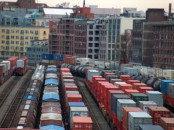Are protectionist policies keeping productivity low?
Currently, the government seems to prefer shielding firms from import competition

While an ominous cloud carrying large raindrops signalling high risks of economic default hangs over Pakistan, challenges on the external front continue to surmount.
According to trade statistics provided by the Pakistan Bureau of Statistics (PBS), Pakistan continued to report a decline in its exports in January 2023. Exports reported at $2.2 billion in January 2023, were 4.4% lower than the value in December 2022 and 15.4% lower than the value reported in January 2022.
Imports also declined in January 2023, down by 5.8% month-on-month and 19.6% lower year-on-year. Cumulatively, exports valued at $16.5 billion in the first seven months of FY 23, down 7.2% year-on-year and imports valued $36.1 billion, down by 22.5%. Although, the trade deficit has decreased in the first seven months by 32% year-on-year, the economic crisis continues unabated.
One of the biggest issues that Pakistan faces on the external front is the sharp depletion of foreign exchange reserves held by the State Bank of Pakistan (SBP). According to the data released by the SBP, the foreign exchange reserves held by the central bank have tanked below the $3 billion mark. It was $5.6 billion at the end of December 2022.
Although, the government does seem to be confident in successfully concluding its negotiations with the International Monetary Fund (IMF), the fall in reserves to such critical levels is deeply concerning as it has significant implications on the value of the Pakistani rupee in respect to the US dollar.
The lack of foreign exchange reserves not only suggests the government’s inability to meet its external debt obligations but also provides further impetus to currency speculators and operators in the informal currency market to put pressure on the exchange rate. The government must ensure that it not only negotiates with the IMF to secure the much-needed external financing – to buffer up the foreign exchange reserves – but also encourages long-term revival policies that reduce the possibility of a recurring balance of payments crisis.
Several economic experts have strongly recommended that the government focus on increasing its exports, given that exports have remained stagnant barely breaching the $30 billion mark. This becomes increasingly crucial as larger economies within the region have not only reported significant but sustainable growth in exports.
The potential from exports, compared to the actual flows, is significantly larger as exports only contribute 10% of the total GDP in Pakistan. This ranks Pakistan below several sub-Saharan African economies and smaller island states in the Pacific Ocean – which not only have a relatively smaller population and economic size but are also relatively more economically isolated. Pakistan is fortunate to not only share its borders with two of the world’s largest economies but several major historical trade routes pass through its land.
In addition to this, the advent of the China-Pakistan Economic Corridor (CPEC) was heralded as an opportunity to turn a new economic front and escape the vicious balance of payment cycle that recurs every few years. Unfortunately, Pakistan has been unable to increase its exports in a sustainable manner nor has it been able to overcome its recurring balance of payment crisis.
A major reason behind exports failing to rise in a sustainable manner is the lack of productivity reported in the country’s major industrial sectors.
According to the World Development Indicators provided by the World Bank, Pakistan has limited manufacturing activities with its contribution in total GDP at 12% in 2021. In comparison, it was 21% for Bangladesh, 25% for Vietnam and 27% for China and Thailand. Both Bangladesh and Vietnam witnessed significant growth in its manufacturing activities as a percentage of GDP in the previous decade. This is likely to explain the spurt in their exporting activities in the recent years.
The manufacturing value added per capita has remained stagnant for Pakistan since the early 2000s, while increasing more than five times for both Bangladesh and Vietnam. The value added by the manufacturing sector per capita in Pakistan was the highest with respect to that reported in Bangladesh, Vietnam and India in the mid-1990s. This trend has now reversed, with Pakistan reporting much lower values than its counterparts.
The World Bank’s recently published report, titled “From Swimming in Sand to High and Sustainable Growth: A Roadmap to Reduce Distortions in the Allocation of Resources and Talent in the Pakistani Economy”, evaluates several of the key challenges faced by Pakistan as it struggles with low levels of productivity. It finds that the lack of export promotion policies hurt productivity as exporters in Pakistan do exhibit higher levels of productivity in comparison to non-exporters. High import duties on various goods have not only made the producers in Pakistan inward-looking but have also reduced their ability to lower their costs of production, which is necessary to boost exporting activities of firms.
Further, it is important to mention that smaller exporters are unable to avail export financing facilities due to large administrative costs and processes that disproportionately affect smaller firms. In essence, trade policies have failed to generate the necessary productivity premium required to boost export participation of firms in Pakistan.
In summary, the lack of productivity growth in Pakistan is an important challenge that affects its ability to participate in exporting activities. It is widely accepted that countries that have opened up to international trading activities, experiencing higher trade levels as a percentage of GDP, have exhibited stronger linkages with growth in their productivity levels. Many Asian countries set an example as they have transformed themselves into exporting and manufacturing powerhouses. Pakistan stands as a laggard in this regard. It is critical for Pakistan to introduce policies that encourage participation in trading activities and increase the level of competition and innovation within the country.
Currently, the government seems to prefer shielding firms from import competition with inward-looking protectionist policies. Unfortunately, this has pushed Pakistan further into the vicious trap involving a recurring balance of payment crisis. Better strategies to boost productivity levels are the need of the hour.
The writer is the Assistant Professor of Economics and Research Fellow at CBER, Institute of Business Administration, Karachi
Published in The Express Tribune, February 13th, 2023.
Like Business on Facebook, follow @TribuneBiz on Twitter to stay informed and join in the conversation.



















COMMENTS
Comments are moderated and generally will be posted if they are on-topic and not abusive.
For more information, please see our Comments FAQ